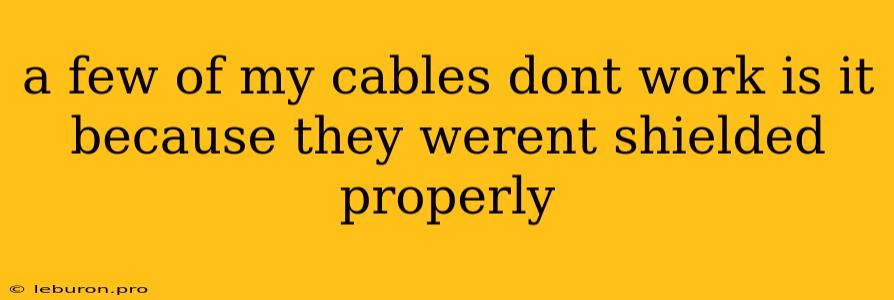Why Are Some of My Cables Not Working? Could Shielding Be the Issue?
Have you ever encountered a situation where some of your cables are working flawlessly while others seem to malfunction? You've meticulously connected everything, but the signal just won't pass through certain cables. Frustrating, isn't it? While several factors can contribute to cable malfunction, one often overlooked culprit is improper shielding. In this article, we delve into the intricacies of cable shielding and explore how it can significantly impact your cable performance. Understanding the role of shielding in cable functionality can be your key to troubleshooting those pesky connectivity issues.
The Importance of Shielding in Cables
Cable shielding serves as a protective barrier against external electromagnetic interference (EMI) and radio frequency interference (RFI). These interferences, often present in our everyday environments, can corrupt data signals traveling through cables, resulting in signal degradation, noise, and ultimately, unreliable performance.
How Shielding Works
Shielding works by creating a Faraday cage around the cable's conductor. This cage, usually made of a conductive material like braided copper or aluminum foil, acts as a barrier to prevent external electromagnetic fields from penetrating the cable. Essentially, the shielding material redirects these interfering signals to ground, preventing them from interfering with the data signals traveling through the cable's conductor.
Types of Cable Shielding
Different cable types employ various shielding methods to achieve optimal protection against interference. Some common types include:
- Braided Shielding: This type of shielding uses a mesh of interwoven wires to create a continuous conductive layer around the cable. Braided shielding offers excellent flexibility and provides relatively good protection against EMI/RFI.
- Foil Shielding: A thin layer of aluminum foil encases the cable's conductor, offering a complete barrier to external electromagnetic fields. Foil shielding provides excellent shielding effectiveness but can be less flexible than braided shielding.
- Combined Shielding: Combining both braided and foil shielding provides the best of both worlds – excellent flexibility and high shielding effectiveness. This is often the preferred shielding method for high-performance cables.
Common Causes of Shielding Issues in Cables
Several factors can contribute to improper shielding in cables, ultimately leading to performance issues. Some of these factors include:
- Improper Manufacturing: Defective shielding during cable manufacturing can leave gaps or weak points in the protective barrier.
- Damage to Shielding: Physical damage to the cable's outer jacket or shielding layer can compromise its effectiveness, allowing interference to penetrate.
- Insufficient Shielding: Some cables might have inadequate shielding for their intended application. For instance, using a cable with minimal shielding in an environment with high levels of EMI can lead to signal degradation.
- Improper Termination: Incorrectly terminated cables can create gaps in the shielding, allowing interference to enter.
Troubleshooting Shielding Issues
If you suspect that shielding is the culprit behind your cable problems, you can investigate these potential issues:
- Visual Inspection: Carefully examine the cable for any physical damage, such as cuts, tears, or broken shielding.
- Electromagnetic Environment: Evaluate the surrounding environment for sources of electromagnetic interference. For instance, are there motors, transformers, or other devices that could be generating EMI?
- Grounding: Ensure that the cable is properly grounded. Improper grounding can create a pathway for interference to enter the cable.
- Signal Quality: Check the signal quality at both ends of the cable. Use a network analyzer or other testing equipment to assess the signal-to-noise ratio.
What to Do When Your Cables Don't Work Due to Shielding
If your cables are exhibiting signs of malfunction due to shielding issues, there are several steps you can take to resolve the problem:
- Replace the Cable: If the cable is physically damaged or has inadequate shielding, it's best to replace it with a new one.
- Use a Shielded Cable: Consider using a higher-quality shielded cable if you suspect the current one lacks sufficient protection against EMI/RFI.
- Employ Shielding Measures: You can enhance shielding by using cable wraps or other shielding materials to create a more effective barrier around the cable.
- Improve Grounding: Ensure proper grounding at both ends of the cable to minimize the impact of interference.
Conclusion
Shielding plays a crucial role in ensuring reliable data transmission through cables. Understanding the importance of shielding, the different types available, and common issues that can arise can help you diagnose and troubleshoot cable problems effectively. When dealing with cables, always prioritize quality and proper shielding to avoid performance issues and ensure a smooth and reliable connection. Remember, sometimes the solution to your cable problems might be as simple as using a shielded cable or ensuring it's properly grounded. By addressing shielding issues proactively, you can minimize downtime and enhance the overall performance of your data transmission systems.
